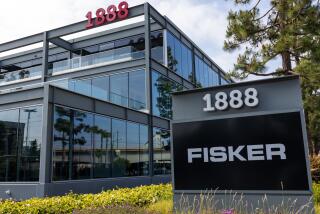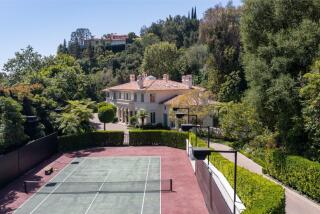At Chrysler, Iacocca Should Blame Himself
- Share via
“For all sad words of tongue or pen,” wrote John Greenleaf Whittier, “the saddest are these, ‘It might have been.’ ”
Lee A. Iacocca, chairman of Chrysler, is on the public stump again, declaiming virtues in Chrysler cars and criticizing shortcomings in Japanese cars--like a baseball manager trying to stir excitement when the team is down.
“We’re going through a bad patch here,” admits Iacocca in an interview. The company that Iacocca and government loan-guarantees brought back from near bankruptcy in 1980 is in the midst of both a $1.5-billion cost reduction program--closing plants in Detroit, St. Louis and Kenosha, Wis.--and a five-year, $15-billion investment program, trying to get the products it needs to stay in the competitive car business in the 1990s.
“Given the market conditions, I think we’re doing a super job. But if people are saying ‘my God they’re in trouble,’ and it begins to affect my sales, then I have to go out on the stump and say this is bull. That’s just red-blooded American salesmanship,” says Iacocca, 65, the man who launched the Mustang at Ford in the 1960s and the minivan at Chrysler in the 1980s.
But Iacocca has himself to blame for Chrysler’s dilemma. The $35-billion (sales) company doesn’t have the cars to compete. Its main line of cars is old now, and though it has profitable minivans and Jeeps, it won’t have its new LH and LX series in the showrooms until August, 1992.
Meanwhile, Honda is bringing out variations on its top-selling Accord, beefing up the Acura line and moving to overtake Chrysler in car sales. Other Japanese car makers are expanding U.S. production also, while U.S. auto makers are struggling.
The story of Iacocca and Chrysler in the 1980s says a lot about why.
Chrysler played to tie, not to win. Instead of reinvesting in the car business when its finances had recovered in the mid-80s, the company went on the defensive--along with the other U.S. car makers.
“We had all this money, making $1.5 billion a year after taxes, and we got too fat,” says Iacocca.
Chrysler spent $1 billion to acquire two companies in aerospace-defense--deciding that government business was safer than competing in a crowded car market. And it spent another $1.4 billion buying back its own stock.
But now it has sold the bulk of its aerospace holdings to invest again in cars. So the question arises: Could those billions in the ‘80s have been better invested in automobiles?
Iacocca’s answer seems to say that any effort might have failed, so it was better to do nothing:
“We’d like to have the LH-LX cars, but you can’t do it all at one time. We might have thrown in another billion of investment, but that would mean doubling the technical staff, hiring engineers I’d later have to lay off and expanding my operating budget. It would be gambling that the billion will pay off in three or four years,” says Iacocca.
Yet Honda, a company with lower sales than all the U.S. car companies, invested a greater percentage of its cash in the car business each year than Chrysler. Honda honed its manufacturing, and produced multivalve engines--which Chrysler now must develop.
“In the next five years we’re going multivalve, so it’s not that they invented something. It’s that they moved fast,” says Iacocca, a 44-year veteran of the industry who seems bewildered by the competition.
“But it’s not so much that they’re faster on their feet,” he says, “it’s that they seem to have capital available from the great savings pool that we don’t have in this country.”
But Chrysler had capital to spare--and it used it to buy in stock, providing a boon to shareholders and to Iacocca and other Chrysler executives who cashed in stock options. Iacocca made $23.6 million in 1986 salary and stock gains. The following year he made $17.9 million.
“I never get defensive about that,” he says. Chrysler stock went from under $10 a share to over $100. (The stock was later split.) “I kept mine to $100,” says Iacocca. “I’m 65, I sold options, and for a couple of years got a lot of money. That’s the free enterprise system. What do you want me to do? I made the stock go up.”
But now the stock is down: It closed Tuesday at $15.875, down from a 1987 high of $48 (adjusted for splits). So this is a harder time to make the $3 billion a year investments in cars that Chrysler is making. But it has no choice--Japanese car makers have taken a technical lead on the Americans, say analysts such as Joseph Phillippi of Shearson Lehman Hutton. And Chrysler, smallest of the Big Three, is vulnerable.
Will Chrysler survive? “Oh God yes,” says Iacocca, vehemently denying rumors that ultimately the company will merge with its joint venture partner Mitsubishi. “No way,” says Iacocca. “We’d die before we’d sell out to the Japanese.”
“Chrysler has enough cash flow for three years,” says analyst Charles Brady of Oppenheimer & Co., and sufficient room to maneuver until it gets its new LH line. “Then will come the real test.”
Meanwhile, Iacocca has hinted he may postpone his retirement, currently slated for 1991--he has to keep the flag flying, and anyway he doesn’t want it said that he saved the company, made his millions and walked away in time of trouble. “Don’t count us out,” says Iacocca.
But if he had invested more in the car business, Iacocca might already have retired in triumph. And Chrysler might not be so vulnerable, and it might not be laying off thousands of employees today. The saddest words, as Whittier said, it might have been.





